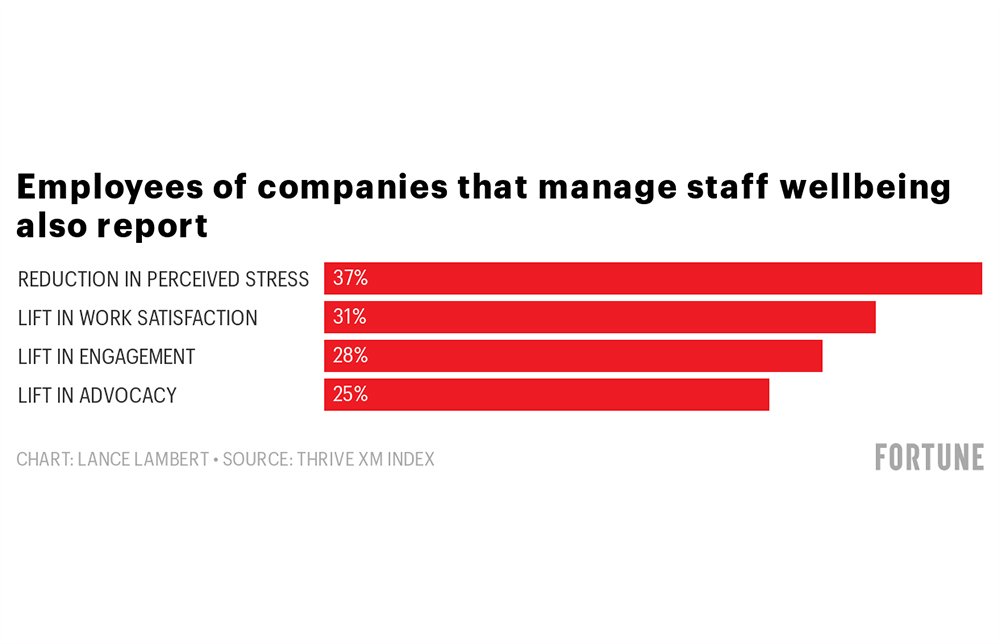《财富》携手Thrive Global、SAP SuccessFactors和Qualtrics创建了Thrive XM指数,对员工福祉最好的公司进行排名。
为了编制这项指数,我们抽样调查了900多家公司的20,000多名全职美国员工。我们的问题涵盖方方面面:工作与生活的平衡、职业发展、心理健康,以及公司政策。
以这项大规模调查为基础,Thrive Global的研究人员使用了一种评分算法来生成公司得分。
然后,他们仔细观察在这项指数中排名最高的公司,看看更好的员工体验是否转化为更好的财务业绩。
以下是他们的发现。
需要知道的数字
今年,到目前为止在Thrive XM指数中排名前10%公司的平均股市回报率为27.2%。
在那些对公司处理职场冲突的方式感到满意的员工中,员工留任的可能性预计增加了34%。
在那些认为公司重视心理健康的员工中,员工留任的可能性预计增加了37%。
在那些最能帮助员工学习新技能的公司中,员工绩效预计增长了21% 。
从2019年到2020年,Thrive XM指数排名前10%公司的《财富》世界500强排名平均上涨11个位次。
大局
一个意想不到的发现是,商业成功与员工福祉密不可分。在利润和股价增长方面,Thrive XM指数中排名靠前公司的表现均优于同行——即使在疫情期间也是如此。一大启示是:不要把员工或同事的幸福感视为理所当然。它也会对企业的盈亏底线产生深远影响。
一些更深层次的启示

1. 道理很简单:快乐的员工等于快乐的股东。
自3月下旬以来,标普500指数从2,304点反弹至3,380点。但各个行业的反弹走势极不均匀,一些公司的市值翻了一番,而另一些公司的市值仍接近3月份的低点。
即使将行业因素考虑在内,排名靠前的Thrive XM指数公司的股价涨幅也超过同行。在2020年第二季度,排名前10%的Thrive XM指数公司的股本回报率攀升了27.2%。
利润方面也是如此。在Thrive XM指数排名前10%的公司中,息税折旧摊销前利润(EBITDA) 攀升了24.8%。
或许,利益相关者资本主义终究对股东也有利?

2. 在一些注重管理员工心理健康的公司中,员工的工作投入度大幅提升。
一些雇主在灵活处理员工心理健康方面获得高度评价,其员工团队承受的压力也相对较小。
鉴于员工在新冠疫情期间的焦虑和抑郁情绪普遍高涨,雇主们比以往任何时候都更需要注重管理员工的心理健康。
“我们必须从根本上重新设想我们的工作文化,要把建设心理适应力放在核心位置。这意味着要从倦怠文化转向一种以幸福感为中心的文化。”参与设计Thrive XM指数概念的著名媒体人、企业家阿里安娜•赫芬顿这样写道。

3. 在帮助员工学习新技能的公司中,其员工绩效大幅提升。
在帮助员工学习新技能方面排名靠前的公司,其员工队伍的绩效提高了21%,员工留任的可能性也提高了31%。
想要削减招聘成本吗?也许你应该多掏一些钱资助员工上夜校。(财富中文网)
译者:任文科
《财富》携手Thrive Global、SAP SuccessFactors和Qualtrics创建了Thrive XM指数,对员工福祉最好的公司进行排名。
为了编制这项指数,我们抽样调查了900多家公司的20,000多名全职美国员工。我们的问题涵盖方方面面:工作与生活的平衡、职业发展、心理健康,以及公司政策。
以这项大规模调查为基础,Thrive Global的研究人员使用了一种评分算法来生成公司得分。
然后,他们仔细观察在这项指数中排名最高的公司,看看更好的员工体验是否转化为更好的财务业绩。
以下是他们的发现。
需要知道的数字
今年,到目前为止在Thrive XM指数中排名前10%公司的平均股市回报率为27.2%。
在那些对公司处理职场冲突的方式感到满意的员工中,员工留任的可能性预计增加了34%。
在那些认为公司重视心理健康的员工中,员工留任的可能性预计增加了37%。
在那些最能帮助员工学习新技能的公司中,员工绩效预计增长了21% 。
从2019年到2020年,Thrive XM指数排名前10%公司的《财富》世界500强排名平均上涨11个位次。
大局
一个意想不到的发现是,商业成功与员工福祉密不可分。在利润和股价增长方面,Thrive XM指数中排名靠前公司的表现均优于同行——即使在疫情期间也是如此。一大启示是:不要把员工或同事的幸福感视为理所当然。它也会对企业的盈亏底线产生深远影响。
一些更深层次的启示
Thrive XM指数中排名靠前公司的表现优于《财富》500强同行,基于2020年第二季度的财务数据。数据来源:Thrive XM指数
1. 道理很简单:快乐的员工等于快乐的股东。
自3月下旬以来,标普500指数从2,304点反弹至3,380点。但各个行业的反弹走势极不均匀,一些公司的市值翻了一番,而另一些公司的市值仍接近3月份的低点。
即使将行业因素考虑在内,排名靠前的Thrive XM指数公司的股价涨幅也超过同行。在2020年第二季度,排名前10%的Thrive XM指数公司的股本回报率攀升了27.2%。
利润方面也是如此。在Thrive XM指数排名前10%的公司中,息税折旧摊销前利润(EBITDA) 攀升了24.8%。
或许,利益相关者资本主义终究对股东也有利?
注重管理员工福祉的企业点员工报告。数据来源:Thrive XM指数
2. 在一些注重管理员工心理健康的公司中,员工的工作投入度大幅提升。
一些雇主在灵活处理员工心理健康方面获得高度评价,其员工团队承受的压力也相对较小。
鉴于员工在新冠疫情期间的焦虑和抑郁情绪普遍高涨,雇主们比以往任何时候都更需要注重管理员工的心理健康。
“我们必须从根本上重新设想我们的工作文化,要把建设心理适应力放在核心位置。这意味着要从倦怠文化转向一种以幸福感为中心的文化。”参与设计Thrive XM指数概念的著名媒体人、企业家阿里安娜•赫芬顿这样写道。
注重帮助员工学习新技能的公司中,员工报告。数据来源:Thrive XM指数
3. 在帮助员工学习新技能的公司中,其员工绩效大幅提升。
在帮助员工学习新技能方面排名靠前的公司,其员工队伍的绩效提高了21%,员工留任的可能性也提高了31%。
想要削减招聘成本吗?也许你应该多掏一些钱资助员工上夜校。(财富中文网)
译者:任文科
Fortune teamed up with Thrive Global, SAP SuccessFactors, and Qualtrics to build the Thrive XM Index*, a ranking of companies with the best employee wellbeing.
To create the index, we surveyed a sample of more than 20,000 full-time U.S. employees from over 900 companies. We asked them about everything: work-life balance, career advancement, mental health, company policies.
From this massive survey, Thrive Global researchers used a scoring algorithm to generate the score for companies.
Then they looked at the highest-ranked companies on the index to see if their better employee experiences translated into better financial results.
Here's what they found.
The numbers to know
27.2%
... is the average stock-market return among the top 10% of companies in the Thrive XM Index, year to date.
34%
... is the predicted increase in retention among employees who say they're satisfied with how their company handles workplace conflicts.
37%
... is the predicted increase in retention among employees who say their companies are understanding in regards to mental health.
21%
... is the predicted increase in employee performance among companies that best help staff learn new skills.
11 spots
... are the average jumps up in Fortune 500 rank among the top 10% of companies in the Thrive XM Index, from 2019 to 2020.
The big picture
Surprise: Business success and employee wellbeing go hand in hand. The top-ranked companies on the Thrive XM Index outperformed their peers in terms of profits and stock price growth—through the pandemic, no less. The big takeaway: Don't take your employees' or coworkers' wellbeing for granted. It matters (to the bottom line, too).
A few deeper takeaways
1. It's simple: Happy employees equal happy shareholders.
Since late March, the S&P 500 Index has rebounded from 2,304 to 3,380 points. But that rebound has been wildly uneven across businesses, with some companies doubling in value while others still sit near their March lows.
The top-ranked Thrive XM Index companies—even when factoring in industry—saw their stock gains outperform those of their peers. The top 10% of Thrive XM Index companies saw their return on equity climb 27.2% in the second quarter of 2020.
The same goes for profits: Among the top 10% of Thrive XM Index companies, EBITDA climbed 24.8% in the second quarter.
Maybe stakeholder capitalism is good for shareholders after all?
2. Workplaces that prioritize employees' mental health see lifts in work engagement.
Employers rated highly for being flexible with staff mental health also have less stressed workforces.
And with anxiety and depression soaring during the pandemic, it's more important than ever for employers to take note of mental health.
"We must fundamentally reimagine our work culture to build mental resilience at its core. It means moving from a burnout culture to a culture with wellbeing at the center," Arianna Huffington, who played a role in designing the Thrive XM Index concept, wrote to Thrive and Fortune.
3. Workplaces that help employees learn new skills see improved performance.
The companies ranked higher for helping staff learn new skills have workforces with 21% higher performance—and 31% increase in likelihood of retention.
Want to cut down on your recruiting cost? Maybe pony up more money for night classes for your staff.






